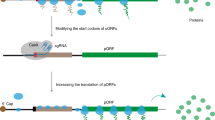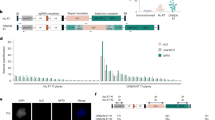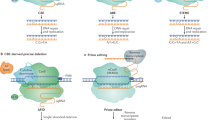Abstract
The molecular basis of transgene susceptibility to silencing is poorly characterized in plants; thus, we evaluated several transgene design parameters as means to reduce heritable transgene silencing. Analyses of Arabidopsis plants with transgenes encoding a microalgal polyunsaturated fatty acid (PUFA) synthase revealed that small RNA (sRNA)-mediated silencing, combined with the use of repetitive regulatory elements, led to aggressive transposon-like silencing of canola-biased PUFA synthase transgenes. Diversifying regulatory sequences and using native microalgal coding sequences (CDSs) with higher GC content improved transgene expression and resulted in a remarkable trans-generational stability via reduced accumulation of sRNAs and DNA methylation. Further experiments in maize with transgenes individually expressing three crystal (Cry) proteins from Bacillus thuringiensis (Bt) tested the impact of CDS recoding using different codon bias tables. Transgenes with higher GC content exhibited increased transcript and protein accumulation. These results demonstrate that the sequence composition of transgene CDSs can directly impact silencing, providing design strategies for increasing transgene expression levels and reducing risks of heritable loss of transgene expression.
This is a preview of subscription content, access via your institution
Access options
Access Nature and 54 other Nature Portfolio journals
Get Nature+, our best-value online-access subscription
$29.99 / 30 days
cancel any time
Subscribe to this journal
Receive 12 digital issues and online access to articles
$119.00 per year
only $9.92 per issue
Buy this article
- Purchase on Springer Link
- Instant access to full article PDF
Prices may be subject to local taxes which are calculated during checkout





Similar content being viewed by others
References
Butaye, K. M., Cammue, B. P., Delaure, S. L. & De Bolle, M. F. Approaches to minimize variation of transgene expression in plants. Mol. Breeding 16, 79–91 (2005).
van der Krol, A., Mur, L., Beld, M., Mol, J. & Stutje, A. Flavonoid genes in petunia: addition of a limited number of gene copies may lead to a suppression of gene expression. Plant Cell 4, 291–299 (1990).
Napoli, C., Lemieux, C. & Jorgensen, R. Introduction of a chimeric chalcone synthase gene into petunia results in reversible co-suppression of homologous genes in trans. Plant Cell 2, 279–289 (1990).
Mette, M. F., van der Winden, J., Matzke, M. A. & Matzke, A. J. Production of aberrant promoter transcripts contributes to methylation and silencing of unlinked homologous promoters in trans. EMBO J. 18, 241–248 (1999).
Matzke, M. A. & Mosher, R. A. RNA-directed DNA methylation: an epigenetic pathway of increasing complexity. Nat. Rev. Genet. 15, 394–408 (2014).
Fultz, D. & Slotkin, R. K. Exogenous transposable elements circumvent identity-based silencing, permitting the dissection of expression-dependent silencing. Plant Cell 29, 360–376 (2017).
Fultz, D., Choudury, S. G. & Slotkin, R. K. Silencing of active transposable elements in plants. Curr. Opin. Plant Biol. 27, 67–76 (2015).
Mari-Ordonez, A. et al. Reconstructing de novo silencing of an active plant retrotransposon. Nat. Genet. 45, 1029–1039 (2013).
Bond, D. M. & Baulcombe, D. C. Epigenetic transitions leading to heritable, RNA-mediated de novo silencing in Arabidopsis thaliana. Proc. Natl Acad. Sci. USA 112, 917–922 (2015).
Panda, K. et al. Full-length autonomous transposable elements are preferentially targeted by expression-dependent forms of RNA-directed DNA methylation. Genome Biol. 17, 170 (2016).
Nuthikattu, S. et al. The initiation of epigenetic silencing of active transposable elements is triggered by RDR6 and 21-22 nucleotide small interfering RNAs. Plant Physiol. 162, 116–131 (2013).
McCue, A. D. et al. ARGONAUTE 6 bridges transposable element mRNA-derived siRNAs to the establishment of DNA methylation. EMBO J. 34, 20–35 (2014).
Fojtova, M., Van Houdt, H., Depicker, A. & Kovarik, A. Epigenetic switch from posttranscriptional to transcriptional silencing is correlated with promoter hypermethylation. Plant Physiol. 133, 1240–1250 (2003).
Kasai, M. et al. Deep sequencing uncovers commonality in small RNA profiles between transgene-induced and naturally occurring RNA silencing of chalcone synthase-A gene in petunia. BMC Genom. 14, 63 (2013).
You, W., Lorkovic, Z. J., Matzke, A. J. & Matzke, M. Interplay among RNA polymerases II, IV and V in RNA-directed DNA methylation at a low copy transgene locus in Arabidopsis thaliana. Plant Mol. Biol. 82, 85–96 (2013).
Walsh, T. A. et al. Canola engineered with a microalgal polyketide synthase-like system produces oil enriched in docosahexaenoic acid. Nat. Biotechnol. 34, 881–887 (2016).
Velten, J., Cakir, C. & Cazzonelli, C. I. A spontaneous dominant-negative mutation within a 35S::AtMYB90 transgene inhibits flower pigment production in tobacco. PLoS ONE 5, e9917 (2010).
Dalakouras, A., Moser, M., Boonrod, K., Krczal, G. & Wassenegger, M. Diverse spontaneous silencing of a transgene among two Nicotiana species. Planta 234, 699–707 (2011).
Jauvion, V., Elmayan, T. & Vaucheret, H. The conserved RNA trafficking proteins HPR1 and TEX1 are involved in the production of endogenous and exogenous small interfering RNA in Arabidopsis. Plant Cell 22, 2697–2709 (2010).
Feng, S. et al. Conservation and divergence of methylation patterning in plants and animals. Proc. Natl Acad. Sci. USA 107, 8689–8694 (2010).
Tatarinova, T., Elhaik, E. & Pellegrini, M. Cross-species analysis of genic GC3 content and DNA methylation patterns. Genome Biol. Evol. 5, 1443–1456 (2013).
James, C. A global overview of biotech (GM) crops: adoption, impact and future prospects. GM Crops 1, 8–12 (2010).
Diehn, S. H., Chiu, W. L., De Rocher, E. J. & Green, P. J. Premature polyadenylation at multiple sites within a Bacillus thuringiensis toxin gene-coding region. Plant Physiol. 117, 1433–1443 (1998).
Diehn, S. H., De Rocher, E. J. & Green, P. J. in Genetic Engineering: Principles and Methods Vol. 18 (ed. Setlow, J. K.) 83–99 (Springer, New York, 1996).
De Rocher, E. J., Vargo-Gogola, T. C., Diehn, S. H. & Green, P. J. Direct evidence for rapid degradation of Bacillus thuringiensis toxin mRNA as a cause of poor expression in plants. Plant Physiol. 117, 1445–1461 (1998).
Larrinua, I., Merlo, D., Reddy, S., Thirumalaiswamysekhar, A. & Woosley, A. Synthetic genes. US patent 20160304900 A1 (2016).
Vaistij, F. E., Jones, L. & Baulcombe, D. C. Spreading of RNA targeting and DNA methylation in RNA silencing requires transcription of the target gene and a putative RNA-dependent RNA polymerase. Plant Cell 14, 857–867 (2002).
Petersen, B. O. & Albrechtsen, M. Evidence implying only unprimed RdRP activity during transitive gene silencing in plants. Plant Mol. Biol. 58, 575–583 (2005).
Bleys, A., Van Houdt, H. & Depicker, A. Down-regulation of endogenes mediated by a transitive silencing signal. RNA 12, 1633–1639 (2006).
Bleys, A., Vermeersch, L., Van Houdt, H. & Depicker, A. The frequency and efficiency of endogene suppression by transitive silencing signals is influenced by the length of sequence homology. Plant Physiol. 142, 788–796 (2006).
Kudla, G., Lipinski, L., Caffin, F., Helwak, A. & Zylicz, M. High guanine and cytosine content increases mRNA levels in mammalian cells. PLoS Biol. 4, e180 (2006).
Barahimipour, R., Neupert, J. & Bock, R. Efficient expression of nuclear transgenes in the green alga Chlamydomonas: synthesis of an HIV antigen and development of a new selectable marker. Plant Mol. Biol. 90, 403–418 (2016).
Barahimipour, R. et al. Dissecting the contributions of GC content and codon usage to gene expression in the model alga Chlamydomonas reinhardtii. Plant J. 84, 704–717 (2015).
Tatarinova, T. V., Alexandrov, N. N., Bouck, J. B. & Feldmann, K. A. GC3 biology in corn, rice, sorghum and other grasses. BMC Genom. 11, 308 (2010).
Plotkin, J. B. & Kudla, G. Synonymous but not the same: the causes and consequences of codon bias. Nat. Rev. Genet. 12, 32–42 (2011).
Bali, V. & Bebok, Z. Decoding mechanisms by which silent codon changes influence protein biogenesis and function. Int. J. Biochem. Cell Biol. 64, 58–74 (2015).
Tuller, T., Waldman, Y. Y., Kupiec, M. & Ruppin, E. Translation efficiency is determined by both codon bias and folding energy. Proc. Natl Acad. Sci. USA 107, 3645–3650 (2010).
Newman, Z. R., Young, J. M., Ingolia, N. T. & Barton, G. M. Differences in codon bias and GC content contribute to the balanced expression of TLR7 and TLR9. Proc. Natl Acad. Sci. USA 113, E1362–1371 (2016).
Kaplan, N. et al. The DNA-encoded nucleosome organization of a eukaryotic genome. Nature 458, 362–366 (2009).
Dekker, J. GC- and AT-rich chromatin domains differ in conformation and histone modification status and are differentially modulated by Rpd3p. Genome Biol. 8, R116 (2007).
Cuerda-Gil, D. & Slotkin, R. K. Non-canonical RNA-directed DNA methylation. Nat. Plants 2, 16163 (2016).
Pikaard, C. S., Haag, J. R., Pontes, O. M., Blevins, T. & Cocklin, R. A transcription fork model for Pol IV and Pol V-dependent RNA-directed DNA methylation. Cold Spring Harb. Symp. Quant. Biol. 77, 205–212 (2012).
Haag, J. R. et al. In vitro transcription activities of Pol IV, Pol V, and RDR2 reveal coupling of Pol IV and RDR2 for dsRNA synthesis in plant RNA silencing. Mol. Cell 48, 811–818 (2012).
Liu, Q., Wang, F. & Axtell, M. J. Analysis of complementarity requirements for plant microRNA targeting using a Nicotiana benthamiana quantitative transient assay. Plant Cell 26, 741–753 (2014).
Dadami, E. et al. An endogene-resembling transgene delays the onset of silencing and limits siRNA accumulation. FEBS Lett. 587, 706–710 (2013).
Acknowledgements
At Dow AgroSciences, we thank M. German for his review and comments on the manuscript; S. Dhavala for initial consultations regarding statistical data analysis; W. Case for Arabidopsis mutant validation, development of high throughput qPCR assays and transgene copy number and zygosity analyses in Arabidopsis and maize; R. Hampton, C. Larsen and M. Foster for Arabidopsis protein analyses; and C. Ransom, V. Stoltz and D. Gachotte for LC-PUFA analyses. We thank S. Jamidar (University of Delaware) and R. McEwan (Dow AgroSciences) for assistance on NGS analyses of maize transgene-derived sRNAs.
Author information
Authors and Affiliations
Contributions
L.V.S., T.L., A.W. and B.C.M. designed studies, executed experiments and interpreted data. L.V.S., T.L., A.W., T.A.W. and B.C.M. cowrote the paper with participation from all authors. Specifically, L.V.S. designed and led execution of Arabidopsis and maize experiments and worked with W.A.M. and S.W. on experiment planning, sample collection, data generation and analyses. T.L. conducted Arabidopsis NGS library preparation and related data analysis. A.W. developed maize transgenes, including CDSs biasing, and led analyses of protein accumulation in maize transgenic plants. W.A.M. conducted Arabidopsis molecular analysis to identify and select plants for studies, and coordinated transfer of materials between labs. S.A.B. developed canola-biased CDS optimizations and designed and participated in building of all of the constructs used in the Arabidopsis study. T.P.G. provided protein data analyses and contributed to writing. P.H.W. designed and executed a subset of maize experiments and contributed to writing. X.Y. and S.S. executed maize sRNA data analyses, interpreted results and prepared figures. X.W. carried out statistical analysis and contributed to writing. P.A.O.M., T.A.W. and B.C.M. conceived the project and provided overall guidance for teams at Dow AgroSciences (P.A.O.M., T.A.W.) and the University of Delaware (B.C.M.).
Corresponding author
Ethics declarations
Competing interests
This work was part of the research and development programs of Dow AgroSciences LLC, a for-profit agricultural technology company. Part of the work was performed within a research collaboration with BCM (affiliated with University of Delaware, DE and Donald Danforth Plant Science Center, MO). L.V.S., A.W., W.A.M., S.A.B., P.A.O.M., T.A.W., X.W., S.W., T.P.G., P.H.W., X.Y. and S.S. were employees of Dow AgroSciences LLC. T.L. and B.C.M. were employees of the University of Delaware, DE and Donald Danforth Plant Science Center, MO. Some of the data was used in patent applications US2013 0150599 A1, US2014 0359900, WO2015 081270 A1.
Additional information
Publisher’s note: Springer Nature remains neutral with regard to jurisdictional claims in published maps and institutional affiliations.
Electronic supplementary material
Supplementary Information
Supplementary Figures 1–16, Supplementary Tables 1–6, Supplementary Methods, Supplementary References
Rights and permissions
About this article
Cite this article
Sidorenko, L.V., Lee, Tf., Woosley, A. et al. GC-rich coding sequences reduce transposon-like, small RNA-mediated transgene silencing. Nature Plants 3, 875–884 (2017). https://doi.org/10.1038/s41477-017-0040-6
Received:
Accepted:
Published:
Issue Date:
DOI: https://doi.org/10.1038/s41477-017-0040-6
This article is cited by
-
Structured 3′ UTRs destabilize mRNAs in plants
Genome Biology (2024)
-
Multiple factors and features dictate the selective production of ct-siRNA in Arabidopsis
Communications Biology (2024)
-
Ribosome stalling and SGS3 phase separation prime the epigenetic silencing of transposons
Nature Plants (2021)
-
Contrasting epigenetic control of transgenes and endogenous genes promotes post-transcriptional transgene silencing in Arabidopsis
Nature Communications (2021)
-
Comprehensive analysis of coding sequence architecture features and gene expression in Arachis duranensis
Physiology and Molecular Biology of Plants (2021)



